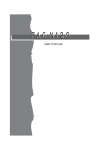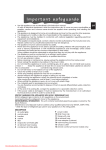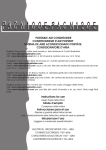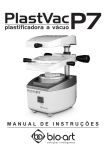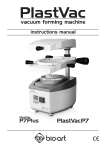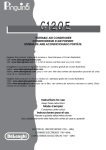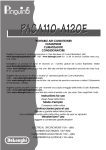Download DeLonghi PAC N120E User manual
Transcript
PA C N 1 2 0 User manual Downloaded from AC-Manual.com Manuals DESCRIPTION 1 2 5 3 6 7 8 9 4 10 ACCESSORIES 11 15 19 Downloaded from AC-Manual.com Manuals 13 12 14 17 16 20 18 21 Important safeguards • Use this appliance only as described in this instruction manual. As with all electrical equipment, whilst the instructions aim to cover as many eventualities as possible, caution and common sense should be applied when operating and installing this appliance. • This appliance is designed for home air conditioning and must not be used for other purposes. • It is dangerous to modify or alter the characteristics of the appliance in any way. • The appliance must be installed in conformity with national legislation regulating electrical equipment and installations. • If the appliance requires repair, contact a Service Centre authorised by the manufacturer only. Repairs carried out by unauthorised personnel may be dangerous. • This appliance must be used exclusively by adults. • Never allow the appliance to be used by people (including children) with psychological, physical or sensory impairments or with insufficient experience and knowledge, unless closely supervised and instructed by someone responsible for their safety. Young children should be supervised to ensure that they do not play with the appliance. • The appliance must be connected to an efficient earth system. Have your electrical circuit checked by a qualified electrician. • Do not use extension cables. • Before cleaning or maintenance, always unplug the appliance from the mains socket. • Never unplug the appliance by pulling on the power cable. • Do not install the appliance in rooms containing gas, oil or sulphur. Do not install near sources of heat. • Keep the appliance at least 50 cm away from flammable substances (alcohol etc) or pressu rised containers (eg aerosol cans). • Do not rest heavy or hot objects on top of the appliance. • Clean the air filter at least once a week. • Avoid using heating appliances near the air conditioner. • Always transport the appliance upright or resting on one side. Before moving the appliance, empty the internal circuit completely of water. After moving the appliance, wait at least 1 hour before starting it • When putting the appliance away, do not cover with plastic bags. • The materials used for packaging can be recycled. You are therefore recommended to dispose of them in special differentiated waste collection containers. • At the end of its working life, consign the appliance to a specialist collection centre. • If the power cable is damaged, it must be replaced by the manufacturer or an authorised technical service centre in order to avoid all risk. SPECIFIC WARNINGS FOR APPLIANCES WITH R410A* REFRIGERANT GAS R410A refrigerant gas conforms to EC regulations on the environment. Avoid perforating the refrigerant circuit of the appliance. ENVIRONMENTAL INFORMATION: This unit contains fluorinated greenhouse gases covered by the Kyoto Protocol. Maintenance and disposal must be carried out by qualified personnel only (R410A, GWP=1975).* Verify the type of refrigerant gas used in your appliance on the rating plate. DESCRIPTION 1 air outlet grille 2 3 4 5 6 7 8 9 10 11 control panel castors handles filter evaporator air intake grille air exhaust hose housing condenser air intake grille power cable drainage hose wall flange 4 Downloaded from AC-Manual.com Manuals 12 13 14 15 16 17 18 19 20 21 air exhaust hose hose adaptor (2 pieces) accessory for wall mounting window bracket grille window bracket cap window bracket additional window bracket 6 screws window outlet remote control Pre p a r i n g f o r u s e ELECTRICAL CONNECTIONS Before plugging the appliance into the mains socket, check that: • The outlet’s power supply corresponds to the value indicated on the rating label on the back of the appliance; • The outlet and electrical circuit are adequate for the appliance; • The outlet is a 3-hole grounded outlet . If this is not the case, you must choose another outlet. Failure to follow these important safety instructions absolves the manufacturer of all liability. The power cable must be replaced by a qualified professional only. The instructions below will enable you to prepare your air conditioner for operation as efficiently as possible. Before use, make sure the air intake and outlet grilles are unobstructed. AIR-CONDITIONING WITHOUT INSTALLATION • Open the window. Just a few simple steps and your comfort is ensured with your air conditioner: • Place the window bracket 17 in the window, extending it to fit the width of the window (fig. C). • Screw one hose adaptor end 12 . 13 to the hose’s C D • Fit the other hose adaptor 13 in the air exhaust hose housing 7 at the back of the appliance (see fig. A). • Screw the other end of the hose to the adaptor, that was already fitted to the appliance (see fig. A). • Once the bracket is extended, it can be locked into his width by tightening the last two screws provided. • Close the window (fig. D). • Place the air conditioner near the window. Insert the assembled exhaust hose 12 into the window bracket grille 17 (fig. E). Make sure the air exhaust hose is unobstructed. • When not used, the window bracket can be closed off with the cap 16 provided. A If you have a sash window • Attach the window bracket grille 15 to the window bracket 17 with the four screws provided 19 (fig. B). B E If you have a very large window • in order to cover your window aperture, use the additional window bracket without holes extending it to the desired dimension, then fix the bracket by using the pins provided. When extracting the window bracket and joining the two pieces pay attention you do not cover the hole or holes (depending on the model). Keep the air hoses as short and free of curves as possible to avoid constrictions. 5 Downloaded from AC-Manual.com Manuals Pre p a r i n g f o r u s e French window 134 5,27 in. • Attach the window outlet 20 to the air exhaust hose as shown in fig. F. 2 1 in the window pane F I • Open the French window slightly and position the outlet 20 as shown in figure G G Keep the air hoses as short and free of curves as possible to avoid constrictions. in the wooden kickboard of a French window in the wall: you are recommended to insulate the section of wall using suitable insulation. • Fit the wall flange 11 into the hole. • Screw the hose 12 to the adaptor 13 , that was already fitted to the appliance (fig. A). • Remove the L plastic end of the hose 1 12 b y unscrewing it and in its 2 place screw the wall mounting accessory 14 (fig. L). • Fit the end of the hose 12 to the wall flange 11 as shown in fig. M. SEMI-PERMANENT INSTALLATION If required, your appliance can also be installed semi-permanently (Fig. H). MAX100 cm MAX 39,37 inches MIN 35 cm MAX 13,77 inches M When the hose 12 is not fitted, the hole can 30 cm H be closed with the flange cap Proceed as follows: • Drill a hole (ø134mm / 5,27 in.) in an outside wall or through a window pane. Respect the height and dimensions of the hole given in figures M and I. 6 Downloaded from AC-Manual.com Manuals 11 . 30 cm NOTE: When installing the air conditioner semi-permanently, you should leave a door slightly open (as little as 1 cm) to guarantee correct ventilation. Control panel THE CONTROL PANEL S O Q P N A B I H G T L M C R D E F DESCRIPTION OF THE CONTROL PANEL A ON/OFF button B MODE selection button Air conditioning, dehumidifying, fan. C Fan speed selection button (MAX/MED/MIN) D Timer button E Programmed operation increase temperature/time button F Programmed operation decrease temperature/time button G Display Displays the temperature values set and the programmed operating time H Timer in operation indicator light I/L/M Fan speed lights N Fan mode light O Air-conditioning mode light P Dehumidifying mode light Q Alarm light R Remote control receiver S Light: the inner temperature is shown on the display T Light: the outdoor temperature is shown on the display Never turn the air conditioner off by unplugging from the outlet. Always press the button, then wait for a few minutes before unplugging. This allows the appliance to perform a cycle of checks to verify operation. 7 Downloaded from AC-Manual.com Manuals Operation TURNING THE APPLIANCE ON Plug into an outlet. Two lines appear on the display indicating that the appliance is in stand-by. Press the ON/STAND-BY button (A). When turned on, the air conditioner starts operating in the same mode as when it was turned off. Press the MODE button (B) until the light corresponding to the desired mode lights up: Light (O): air-conditioning mode Light (P): dehumidifying mode Light (N): fan mode AIR CONDITIONING MODE Ideal for hot muggy weather when you need to cool and dehumidify the room. The display shows the inner temperature: the light (S) turns on. To modify the set temperature, push the (E) or (F) button to reach the desired temperature. The (T) light turns on and the (S) light turns off. (To change from °F to °C or viceversa, press for few seconds both button E and F). After 15 seconds, the inner temperature is shown on the display. The (S) light turns on. You can adjust the temperature only in air conditioning mode. Then select the fan speed by pressing the FAN button (C) until the light corresponding to the required fan speed lights up: MAX: the air conditioner operates at maximum to achieve the target temperature as rapidly as possible MED: reduces noise levels while maintaining a comfortable temperature MIN: for silent operation The most suitable temperature for the room during the summer varies from 75°F to 81°F (24 to 27°C). You are recommended, however, not to set a temperature much below the outdoor temperature 8 Downloaded from AC-Manual.com Manuals Operation FAN MODE Adjust fan speed by pressing the FAN button (C) as described for the air-conditioning mode. Remember that the higher the speed, the more air is filtered. If you select "MIN" speed, less air is filtered but the appliance is also less noisy. DEHUMIDIFYING MODE Ideal for reducing the humidity in a room without lowering or raising the temperature (spring or autumn, damp rooms, rainy spells, etc). When the dehumidifying mode is selected, the light (P) comes on. At the same time, the "MIN" fan speed light (M) comes on. In this mode, other speeds cannot be selected. PROGRAMMING THE TIMER The timer can be used to delay appliance start up or shut down. This avoids wasting electricity by optimising operating periods. How to programme delayed start up • Plug the appliance into a mains socket and press the ON/OFF button (A), then select the required operating mode and other settings (temperature, fan speed, etc). • Press the ON/OFF button (A) again to place the appliance in standby mode. • Press the timer button (D). The timer light "H" flashes. • Use the + (E) or - (F) buttons to set the number of hours delay before the appliance comes on. The time increases or decreases in steps of one hour. The indicator light (H) flashes until the appliance starts up. You can set the appliance to come on with a delay of up to 12 hours. To cancel the timer programme, press the timer button (D) again. Light (H) stops flashing. How to programme delayed shut down • Delayed shut down can be programmed in any operating mode (air conditioning / fan/ dehumidifying). • Press the timer button (D). The timer light "H" flashes. • Use the + (E) or - (F) buttons to set the number of hours delay before the appliance goes off. The time increases or decreases in steps of one hour. The light (H) flashes until the appliance turns off as programmed. At the set time, the air conditioner shuts down and remains in standby. To cancel the timer programme, press the timer button (D) again. Light (H) stops flashing. 9 Downloaded from AC-Manual.com Manuals Using the remote control unit (some models only) MODELS WITH REMOTE CONTROL • Point the remote control at the receiver on the air conditioner. The remote control must be no more than 16,4 ft (5 metres) away from the appliance (without obstacles between the remote control and the receiver). • The remote control must be handled with extreme care. Do not drop it or expose it to direct sunlight or sources of heat. MAX 16,4 ft MAX 5 metres DESCRIPTION OF THE REMOTE CONTROL 22) "ON/OFF" button 23) Increase /Decrease button for temperature/programmed use 24) "MODE" button 25) "TIMER" button 26) Fan speed selection button (MAX/MED/MIN). 27) °F/°C scale button 22 23 Inserting or replacing the batteries • Remove the cover on the rear of the remote control; • Remove the old batteries, if present. • Correctly insert two new L03 “AAA” 1,5V batteries (see the instructions inside the battery compartment); • Replace the cover. 26 24 25 27 If the remote control unit is replaced or discarded, the batteries must be removed and disposed of in accordance with current legislation as they are harmful to the environment. Do not mix old and new batteries. Do not mix alkaline, standard (carbon-zinc) or rechargeable (nickel-cadmium) batteries. Do not dispose of batteries in fire. Batteries may explode or leak. TURNING THE APPLIANCE ON Plug the appliance into the mains. Press the ON/OFF button (22) (when turned on, the air conditioner starts operating in the same mode as when it was turned off). Press the MODE button (24) to select the required mode COOLING DEHUMIDIFYING FAN ONLY On the control panel, the light corresponding to the selected mode comes on. For air conditioning/dehumidifying/fan only settings and programming the timer, see page 8-9. 10 Downloaded from AC-Manual.com Manuals Tips To get the best from your air conditioner, follow these recommendations: • close the windows and doors in the room to be air conditioned. The only exception is when the appliance is installed through a hole in the wall. In this case, you are recommended to leave a slight draught through a door or window to guarantee correct ventilation. • Never use the appliance in very damp rooms (laundries for example). • Never use the appliance outdoors. close doors and windows • Protect the room from direct exposure to the sun by partially closing curtains and/or blinds to make the appliance much more economical to run; • Never rest objects of any kind on the air conditioner; • Never obstruct the air intake 6 or outlet 1 grilles; • Make sure there are no heat sources in the room. close blinds or curtains • Make sure the air conditioner is on a level floor. do not cover the appliance 11 Downloaded from AC-Manual.com Manuals Cleaning Before cleaning or maintenance, turn the appliance off by pressing the ON/OFF button (A) or in models with remote control unit, by pressing the ON/OFF button 22 , then always unplug the appliance from the mains socket. CLEANING THE CABINET You should clean the appliance with a slightly damp cloth then dry with a dry cloth. For safety reasons, never wash the air conditioner with water. Precautions Never use petrol, alcohol or solvents to clean the appliance. Never spray insecticide liquids or similar. CLEANING THE AIR FILTERS To keep your air conditioner working efficiently, you should clean the dust filter every week of operation. The filter is housed in the intake grille. To clean the filters, remove the filter as shown in figure N. Use a vacuum cleaner to remove the dust collected on the filter. If it is very dirty, immerse in warm water and rinse a number of times. The water should never be hotter than 40°C. After washing, leave the filter to dry. Put the filter back in its housing. START OF SEASON CHECKS Make sure the power cable and plug are undamaged and the earth system is efficient. Follow the installation instructions precisely. END OF SEASON OPERATIONS To drain all water from the circuit, remove the cap from the drain hose on the back of the appliance and allow the water to drain out into a basin (figure O). When the appliance is empty, replace the cap. Clean the filter and dry thoroughly before putting back. N O 12 Downloaded from AC-Manual.com Manuals Troubleshooting NOTE: NEVER TRANSPORT OR TURN THE APPLIANCE UPSIDE DOWN OR ON ITS SIDE. IF THIS OCCURS, WAIT 6 HOURS BEFORE TURNING THE APPLIANCE ON, 24 HOURS IS RECOMMENDED. (After the unit has been on its side, oil needs to return to the compressor to ensure proper function. Without allowing the unit this time (6-24 hours) The unit may function for only a short time, and then the compressor will break down from lack of oil.) TROUBLESHOOTING n PROBLEM CAUSE REMEDY The air conditioning unit does not start. • • • No electricity. It is not plugged into the outlet. The safety device of the plug has tripped. • • • Wait. Plug into the outlet. Contact your service center. The air conditioning unit works for a short time only. • The air exhaust hose has a constriction. • • The air exhaust hose is blocked. • • There are tight bends in the air exhaust hose. • Position the exhaust hose correctly. Check there are no obstacles. Obstructing air discharge. Eliminate the tight bends. The air conditioner works, but does not cool the room. • • Window open. There are heat sources in the room (lamps, etc.). The exhaust hose is detached. Air filters clogged. the air conditioner is not powerful enough for the conditions or size of the room • • close the window eliminate the heat source • • connect the exhaust hose clean or replace the filter Particular odour in the room • air purifying filters clogged • clean or replace the filters The air conditioner does not operate for about 3 minutes after turning it on • the safety device has tripped • wait for three minutes The alarm light Q comes on • the tank inside the appliance is full. • empty the tank (see "End of season operations) on page 12). • • • SELF-DIAGNOSIS The appliance has a self diagnosis system to identify a number of malfunctions. Error messages are displayed on the appliance display. IF…IS DISPLAYED, IF…IS DISPLAYED, IF…IS DISPLAYED, “Low Temperature” “High Temperature” “Probe Failure” (sensor damaged) …MEANS: …MEANS: room temperature is too low room temperature is too high …MEANS: contact your local customer service 13 Downloaded from AC-Manual.com Manuals Technical specifications TECHNICAL SPECIFICATION Power supply voltage see rating label Max. absorbed power during air conditioning “ Refrigerant “ Cooling capacity “ LIMIT CONDITIONS Room temperature for air conditioning 21 ÷ 35°C Transport, filling, cleaning, recovery and disposal of refrigerant should be performed by a technical service centre appointed by the manufacturer only. The appliance should be disposed of by a specialist centre appointed by the manufacturer only. 14 Downloaded from AC-Manual.com Manuals













